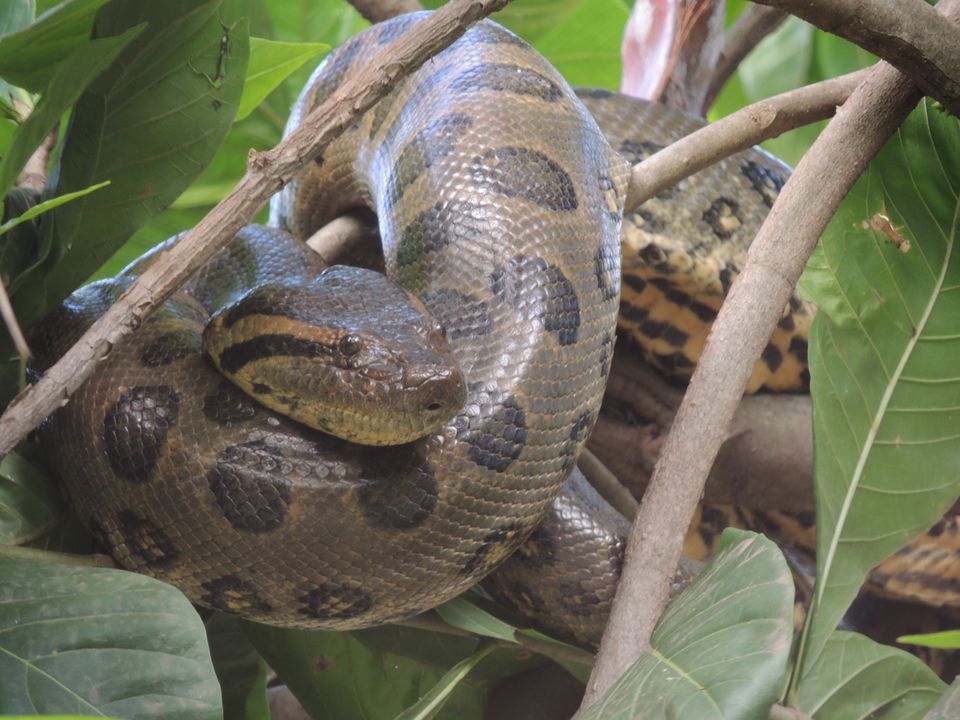
The Bolivian anaconda is a recently discovered species of anaconda that was only identified in 2002.
#PET FULL GROWN GREEN ANACONDA SKIN#
It has a dark brown or black skin with distinctive white spots that help it camouflage in its jungle habitat. The dark-spotted anaconda is a relatively unknown species of anaconda that is found only in a small area of northern South America, including Guyana, Suriname, and French Guiana.

It has a yellowish-brown skin with dark spots, and it is found mainly in the wetlands and grasslands of South America, including Argentina, Brazil, and Paraguay. The yellow anaconda is a smaller species of anaconda, growing up to 10 feet long and weighing up to 60 pounds. It is found mainly in the Amazon Basin, including countries such as Brazil, Peru, and Colombia. It can grow up to 30 feet long and weigh over 500 pounds, making it one of the largest snakes in the world.Īs its name suggests, it has a greenish-brown skin that helps it blend in with the vegetation in its swampy habitat. The green anaconda is the largest and most well-known species of anaconda.

Four Species of Anacondas #1 Green Anaconda By MKAMPIS – Own work, CC BY-SA 4.0, The four known kinds of anacondas: are the green anaconda, the yellow anaconda, the dark-spotted anaconda, and the Bolivian anaconda.Īll of them are impressive constrictor snakes that can be pretty intimidating! The one found in Brazil was a green Anaconda. They have inspired countless legends and myths and captured people’s imaginations for centuries.Īnacondas are part of the Boidae family, including pythons and boas. Hold onto your hats, and get ready for a wild ride into the heart of the jungle! Massive head of Anaconda Chain to pull the Anaconda Crane to lift the AnacondaĪnacondas are some of the largest and most fearsome snakes in the world. In this exciting post, we’ll explore Anacondas’s awe-inspiring and terrifying world and delve into the shocking discovery of the largest one ever seen. Watch a Great White Shark next to a surfer in California.Bald Eagle Swoops Down and Snatches Small Dog.Heroic Florida Man Saves Beloved Dog from Jaws of Gigantic Alligator.Motherly Love: Witness Scenes From Africa’s Wild Moms.Puma’s Jaw-Dropping Face-off with a Guanaco.3D-Printed Brace Restores Sea Turtle’s Health and Hope.The Top 10 Fastest Animals in The World.Discovering The Potency Of King Cobra Bites.Animals That Start with A – Full List, Images, Facts.Though considered to have a stable population overall, in some areas capybaras are severely threatened by people who hunt them for their skin, and some local populations have been wiped out. Females usually have one litter of four to five young per year. Their breeding season varies throughout the year depending on what habitat they live in and the availability of mates. Breeding and populationĬapybaras don’t mind being alone, but they also live in groups of up to 40. Because the grasses they eat are so hard to digest, eating their waste essentially allows them to digest it twice. That’s when their poo is protein rich from the high number of microbes digesting the previous day’s meals. They also eat their own feces in the morning. Like other rodents, capybaras’ teeth grow continuously, and they wear them down by grazing on aquatic plants, grasses, and other plentiful plants. Capybara young have even more to worry about-they are a favorite snack food of snakes like the boa constrictor, crab-eating foxes, small cats, and birds of prey like the caracara and black vulture.Īlong with the seasons, the presence of predators affects what time of day capybaras are active-which may be day or night, and is often at dawn and dusk. Small eyes, noses, and hairless ears are located high on their heads so that their faces remain exposed and alert when most of their body is submerged.īeing alert is important when you’re often dinner for jaguars, pumas, and, in the water, caimans. Their toes are partially webbed for paddling around, and their reddish to dark brown fur is long and brittle-perfect for drying out quickly on land.

Their pig-shaped bodies are adapted for life in bodies of water found in forests, seasonally flooded savannas, and wetlands. Like beavers, capybaras are strong swimmers. They’re closely related to guinea pigs and rock cavies, and more distantly related to chinchillas and agouti. These impressive semi-aquatic mammals are found throughout much of northern and central South America, though a small invasive population has been seen in Florida. You thought the beaver was a rodent of unusual size? The capybara is twice that big-the biggest rodent on Earth.


 0 kommentar(er)
0 kommentar(er)
